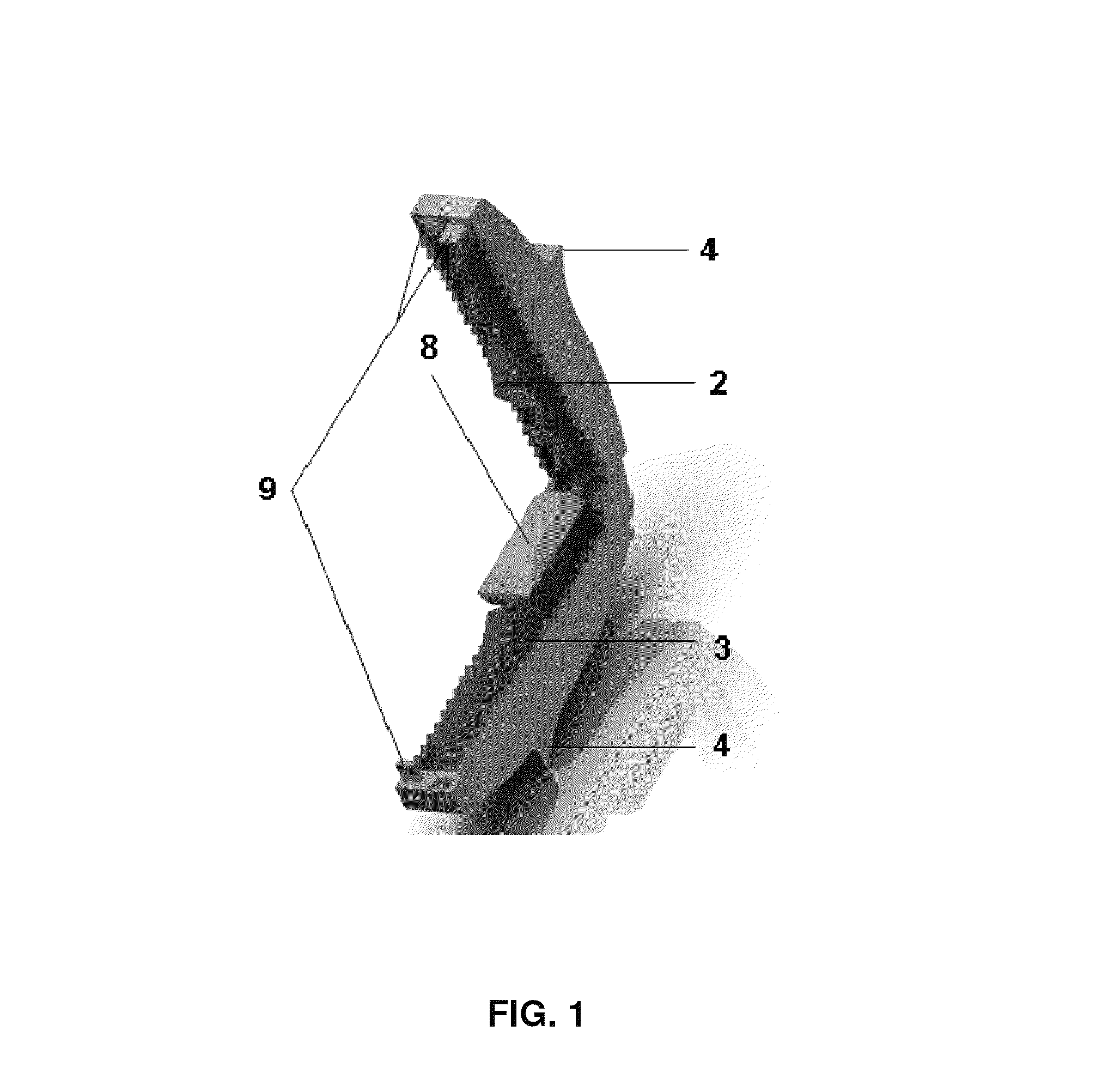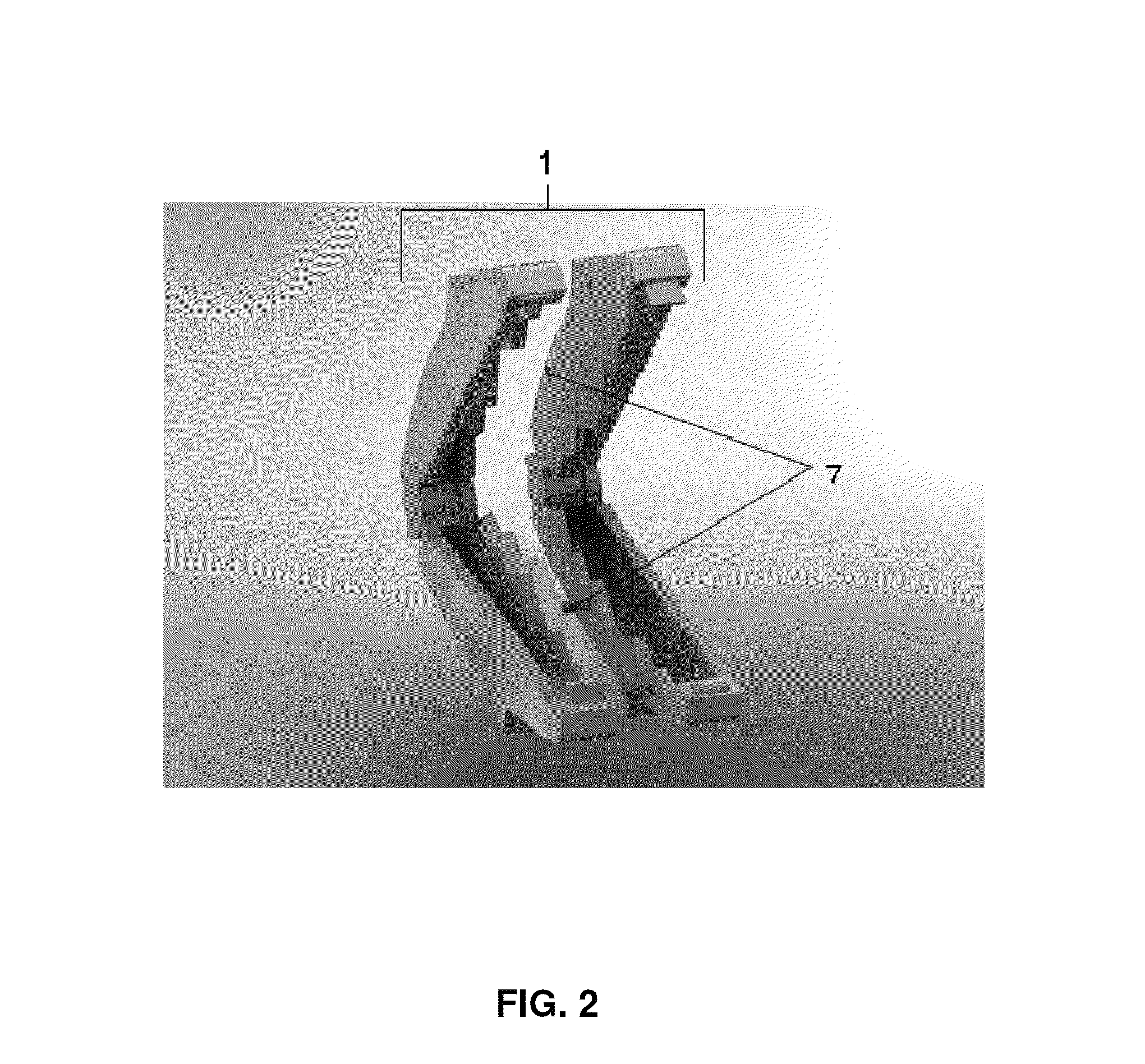Combined umbilical cord cutter, clamp, and disinfectant
a technology of umbilical cord and disinfectant, which is applied in the field of combined umbilical cord clamps, cutters, disinfectants, and data collection systems, can solve the problems of poor access to quality care, contaminated with bacteria and spores, and a much higher infant mortality rate, so as to reduce the likelihood of exposure and reduce infant mortality and the effect of spreading
- Summary
- Abstract
- Description
- Claims
- Application Information
AI Technical Summary
Benefits of technology
Problems solved by technology
Method used
Image
Examples
first embodiment
[0023]In the first embodiment illustrated in FIGS. 1, 2, 3, and 4, two symmetric units composed of a sufficiently hard plastic material to cut umbilical tissue and embedded with an RFID chip fit together and form a thin, oval shape (1). This guides the umbilical tissue to the center of the device, producing an even cutting motion as the device is being closed. The use of two identical units allows the orientation of the device to be irrelevant during use.
[0024]Each unit has a saw-toothed chamfered cutting blade with the largest blade in the center to allow the largest cut to be made in the center of the umbilical cord (2). The chamfered edges of the blade provide shearing strength, thereby allowing the blade to be manufactured in the same hard plastic as the rest of the device (1). Once closed, the chamfered edge produces a seal, preventing the umbilical cord from being exposed to the environment. The blades of the symmetric units are flush with one another when the units are togeth...
second embodiment
[0032]In the second embodiment illustrated in FIGS. 5 and 6, two symmetric units composed of a sufficiently hard plastic material to cut umbilical tissue embedded with an RFID chip fit together to form a thin, S-curved shape (21). This guides the umbilical tissue to the center of the device, producing an even cutting motion as the device is being closed. The use of two identical units allows the orientation of the device to be irrelevant during use.
[0033]Each unit has a saw-toothed chamfered cutting blade with a semi-circular shape to allow for an even cutting motion (22). The chamfered edges of the blade provide shearing strength, thereby allowing the blade to be manufactured in the same hard plastic as the rest of the device (21). Once closed, the chamfered edge produces a seal, preventing the umbilical cord from being exposed to the environment. The blades of the symmetric units are flush with one another, creating a single cutting site along the umbilical cord.
[0034]Each unit al...
third embodiment
[0040]In the third embodiment illustrated in FIGS. 7, 8 and 9, two symmetric units composed of a sufficiently hard plastic material to cut umbilical tissue embedded with an RFID chip fit together and form an oval shape (31). This guides the umbilical tissue to the center of the device, producing an even cutting motion as the device is being closed. The use of two identical units allows the orientation of the device to be irrelevant during use.
[0041]Each unit has a saw-toothed chamfered cutting blade with a semi-circular shape to allow for an even cutting motion (32). The chamfered edges of the blade provide shearing strength, thereby allowing the blade to be manufactured in the same hard plastic as the rest of the device (31). Once closed, the edge of each unit produces a seal, preventing the umbilical cord from being exposed to the environment. Each blade is completely enclosed by its respective symmetric unit; therefore, there are two cutting sites along the umbilical cord.
[0042]E...
PUM
 Login to View More
Login to View More Abstract
Description
Claims
Application Information
 Login to View More
Login to View More - R&D
- Intellectual Property
- Life Sciences
- Materials
- Tech Scout
- Unparalleled Data Quality
- Higher Quality Content
- 60% Fewer Hallucinations
Browse by: Latest US Patents, China's latest patents, Technical Efficacy Thesaurus, Application Domain, Technology Topic, Popular Technical Reports.
© 2025 PatSnap. All rights reserved.Legal|Privacy policy|Modern Slavery Act Transparency Statement|Sitemap|About US| Contact US: help@patsnap.com



